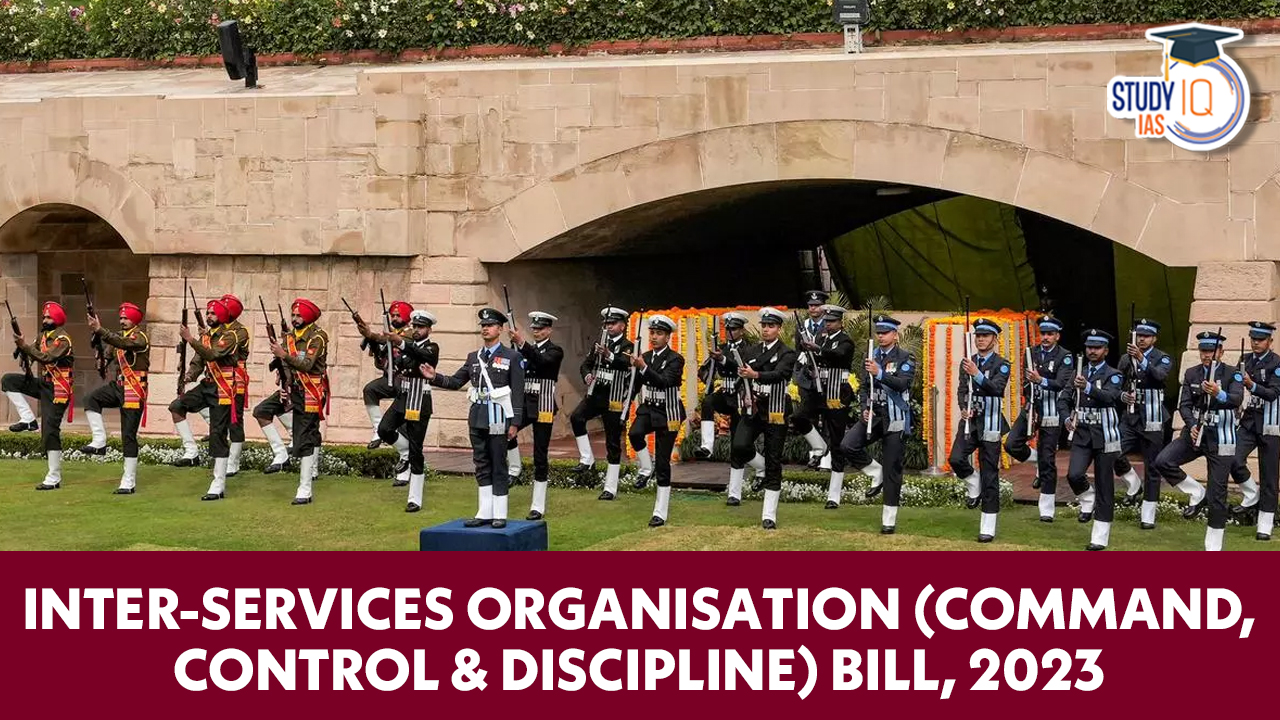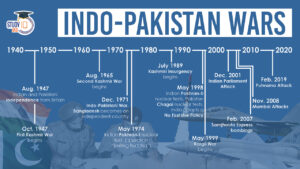Table of Contents
Context: The Lok Sabha recently passed the Inter-Services Organisation (Command, Control and Discipline) Bill, 2023.
More on the News
- There is a proposed reorganisation of the Indian military into integrated theatre commands.
- This means that the current structure of separate service-based commands (Army, Navy, and Air Force) might be transformed into integrated commands to enhance coordination and joint operations.
The rationale behind the proposed law
- Currently, soldiers from their respective services are governed by different Acts of Parliament- Navy Act of 1957, the Air Force Act of 1950, and the Army Act of 1950.
- Under these acts, officers can exercise disciplinary powers only over personnel from their own service.
- This has created administrative and disciplinary challenges in joint service setups, as officers from one service do not have the necessary authority over personnel from another service.
Key provisions of the Bill
- Inter-services Organisation: As per the bill, the central government may constitute an Inter-services Organisation which has personnel belonging to at least two of the three services: the army, the navy, and the air force.
- Control of Inter-services Organisations: The Bill empowers the Commander-in-Chief or the Officer-in-Command of an Inter-services Organisation to exercise command and control over the personnel serving in or attached to it.
- He would be responsible for maintaining discipline and ensuring proper discharge of duties by the service personnel.
- Superintendence: The superintendence of an Inter-services Organisation will be vested in the central government. The government may also issue directions to such organisations on grounds of national security, general administration, or public interest.
- Commanding Officer: The Bill provides for a Commanding Officer who will be in command of a unit, ship, or establishment.
- The officer will also perform duties assigned by the Commander-in-Chief or Officer-in-Command of the Inter-services Organisation.
- The Commanding Officer will be empowered to initiate all disciplinary or administrative actions over the personnel appointed, deputed, posted, or attached to that Inter-services Organisation.
- Other forces under central government: The central government may notify any force raised and maintained in India to which the Bill will apply. This would be in addition to army, navy, and air force personnel.
Understanding Integrated Theatre Commands
Background
Indian Armed Forces
- The Indian Armed Forces are the military forces of the Republic of India.
- With strength of over 1.4 million active personnel, India has the world’s second-largest military force and has the world’s largest volunteer army.
- The President of India is the Supreme Commander of the Indian Armed Force, but they work under the management of the Ministry of Defence of the Government of India.
- The ‘Global Firepower Index 2022’ report ranks Indian Armed Forces as the fourth most-powerful military in the world, after the U.S.A, Russia and China.
- Three branches of Indian armed forces:
- Indian Army: It is the land-based branch and is the largest among the three branches. It is responsible for land-based military operations, including ground warfare and counter-terrorism.
- Indian Navy: It is the naval branch and is responsible for safeguarding India’s maritime borders.
- Indian Air Force: It is the aerial branch and is responsible for aerial warfare and the defense of Indian airspace.

Current command structure of Indian Armed Forces
- Each branch of the Indian Armed Forces consists of various commands, each responsible for a specific geographical region or functional area.
- Indian Army Commands:
- The Indian Army is organized into 7 commands with 6 operational commands and one training command.
- These are Western Command, Eastern Command, Northern Command, Southern Command, South Western Command, Training Command, Central Command.
- Each command is headed by a general officer commanding-in-chief (GOC-in-C), known as the army commander. Each command directly reports to the army headquarter at New Delhi.
- Indian Navy Commands:
- The Navy has the following three Commands, each under the control of a Flag Officer Commanding-in-Chief.
- These are Western Naval Command, Eastern Naval Command, and Southern Naval Command.
- The Western and the Eastern Naval Commands are ‘Operational Commands’, and exercise control over operations in the Arabian Sea and the Bay of Bengal respectively. The Southern Command is the Training Command.
- Indian Air Force Commands:
- The IAF currently has five operational commands, each of which is headed by an AOC-in-C (Air Officer Commander-in-Chief) with the rank of Air Marshal.
- These are Western Air Command, Central Air Command, South Western Air Command, Eastern Air Command, and Southern Air Command.
- The IAF also has two additional commands – Training Command and Maintenance Command – to maintain a uniform standard in training and maintenance.
- Joint service commands: At present, there are two joint services commands in India, the first one is Andaman and Nicobar Command (ANC) and the second, being Strategic Forces Command (SFC).
- ANC is the only tri-service theater command of the Indian Armed Forces, based at Port Blair. It was created in 2001 to safeguard India’s strategic interests in Southeast Asia and the Strait of Malacca by increasing rapid deployment of military assets in the region.
- The Strategic Forces Command (SFC), sometimes called Strategic Nuclear Command, forms part of India’s Nuclear Command Authority (NCA). It is responsible for the management and administration of the country’s tactical and strategic nuclear weapons stockpile.
What are Integrated Theatre Commands?
- Combining the resources of all three services (the Army, Navy, and Air Force) under a single commander to secure a particular geographic area is known as integrated theatre commands.
- There are theatre commands in several countries, including China and the United States.
- The reports of the military reforms commission headed by Lt. General (ret.) DB Shekatkar made the concept of Theatre Command a suggestion.
- It suggested setting up three integrated theatre commands: one in the north for the China border; one in the west for the Pakistan border; and one in the south for the sea role.
Need of Integrated Theatre Commands in India
- There are some challenges and limitations associated with the current command structure of the Indian Armed Forces, which include:
- Lack of Centralized Decision-Making: The existing command structure involves multiple independent commands for each service (Army, Navy, Air Force). This decentralized decision-
- making process can sometimes lead to delays, inefficiencies, and coordination challenges, particularly during joint operations.
- Limited Interoperability: The current command structure, with separate service-specific commands, can result in limited interoperability and coordination between the different branches of the armed forces.
- Duplication of Efforts and Resources: With separate commands for each service, there can be duplication of efforts, resources, and infrastructure. This duplication can lead to inefficiencies, unnecessary costs, and suboptimal resource allocation.

Advantages of Integrated Theatre Commands
- Achieving jointness: It will boost overall fighting capabilities and will also create capacities along with seamless command centres to meet future challenges.
- Better synergy: Military assets will be fused into one single command under one operational head who will be responsible for directing and controlling their activities.
- To meet hybrid warfare requirements: As a potential conflict with a major military power like China will extend beyond the typical theatres into the domains of cyber, space, nuclear and covert capabilities.
- Greater efficiency: Major military powers like the US and China, operate via theatre commands as it is seen to be a better means of pooling resources, providing coordinated logistics planning and improving efficiency.
- Systematic planning in acquisition of resources: Integrated approach towards procurement will end piecemeal approach to purchase done by individual services and the requirements of the military as a whole would be formulated.
- Reducing redundancies: By integrating manpower within theatre commands has the potential of redirecting a sizeable portion towards maintenance and modernization of equipment and capabilities.
Challenges with the creation of Integrated Theatre Commands
- Command Structure and Reporting: One of the primary challenges is determining the command structure and the reporting relationships within the integrated theatre commands. The transition requires careful planning and coordination.
- Inter-Service Competition: The intense focus of each service on its own assets and the desire for a larger portion of the defence budget and influence can hinder the creation of synergy among the services.
- Perception of Army Dominance: There are concerns that integrating the commands may perpetuate the perceived dominance of the army and provide it with greater operational control.
- Limited Experience: India has limited experience with integrated theatre commands. The implementation of such commands may require mid-course corrections and adjustments as challenges and issues are identified and addressed.
- Infrastructure and Logistics: Coordinating and synchronizing the infrastructure and logistics requirements across different services can be a complex and resource-intensive task.


 Article 142 of Indian Constitution, Sign...
Article 142 of Indian Constitution, Sign...
 Pakistan-Occupied Kashmir (PoK): History...
Pakistan-Occupied Kashmir (PoK): History...
 List of Indo-Pakistan Wars and Conflicts...
List of Indo-Pakistan Wars and Conflicts...





















